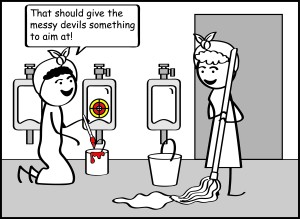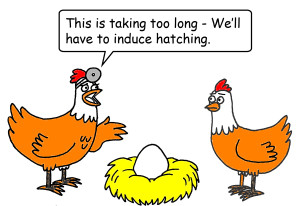I’ve loved cartoons for as long as I can remember. They are the first thing I look for while settling into the Sunday paper. I never thought about why I like cartoons so much until I wrote my book. I open my book with a question: What is the Answer to Being More Creative? This cartoon is a perfect illustration for me.
We don’t hit targets that we don’t aim for; i t takes intention and attention (and humor helps). I have spent many years in creative industries, creating something from nothing. My learning model is we have three distinct sources of creativity, our head, heart and gut intelligence centers. One of these centers of intelligence, whether it’s thinking, feeling, or doing, dominates our pattern of creativity. We begin by understanding what our distinct pattern of creativity is from our three intelligence centers. Then we begin to further develop our lesser-used center(s) in our creative process.
t takes intention and attention (and humor helps). I have spent many years in creative industries, creating something from nothing. My learning model is we have three distinct sources of creativity, our head, heart and gut intelligence centers. One of these centers of intelligence, whether it’s thinking, feeling, or doing, dominates our pattern of creativity. We begin by understanding what our distinct pattern of creativity is from our three intelligence centers. Then we begin to further develop our lesser-used center(s) in our creative process.
How do cartoons help in this process? In the middle ages cartoons were first used to describe a preparatory drawing for a piece of art. Then in the 19th century, cartoons became humorous illustrations in magazines and newspapers, and after the early 20th century, they referred to comic strips and animated films.
This is cartoon history, but for me they give immediate emotional relief– to “lighten up.” My personality can be all too serious. Cartoons often create a needed empathy towards myself and others. The humor results in a guttural laugh that releases built up (and often unconscious) stress in my body. Lastly, the cartoon usually hits my head center’s “inner critic,” causing “it” to shut up… this all allows me to get unstuck and be more creative. So, I’d say for me the general order of a cartoon’s impact is: heart and gut (intersection) then up to my head. But the real beauty of a cartoon’s impact is so fast, so immediate that the order doesn’t really matter much… ultimately it’s a three-center intersection. I think this is why my book is so heavily illustrated, especially with many cartoons. Creating intersections between our intelligence centers is a key to being more creative.
How does this dog walking cartoon hit you— head, heart or gut-wise? Does it create an intersection of center(s) for you?
How about this cartoon, do you ever get pushed/rushed to deliver a creative solution at your job? (Maybe you should show your boss this cartoon). Thank you for reading my post. I am an organizational and business consultant living in the mountains of Santa Fe, New Mexico with my husband and dogs. My core message of everyone is creative resonates with people of all ages and walks of life. I invite all to become the best version of themselves and find true meaning by pursing long term creative quests.
Thank you for reading my post. I am an organizational and business consultant living in the mountains of Santa Fe, New Mexico with my husband and dogs. My core message of everyone is creative resonates with people of all ages and walks of life. I invite all to become the best version of themselves and find true meaning by pursing long term creative quests.
Read more in my book: The Three Sources of Creativity: Breakthroughs from Your Head, Heart and Gut





This response is from Michael Erickson, Visual Practitioner at The Boeing Company (25 years):
“So I build a LOT of cartoons in my work (Visual Practice in Aerospace) and cartoon art permits me to get below the superficial (or surface) material and into that “below the surface” space of emotion and mental model that drives behavior (and what-ever system glitches I’m chasing at the time). Since in corporations, “fear” and “control” influence a LOT of stuff, being able to gently touch existing fears/control-over discontinuities, and to “kid people” a little, enough to make them smile, maybe even laugh out loud lowers the defensiveness and allows people to consider possibilities they would not otherwise touch with a ten foot pole. Living by my own law of “NEVER-belittle, insult or attack” with my cartoon art, but rather, kid, tease and clearly illustrate using humor, I’ve been able to confront some real doozy issues, both without getting fired, but more important, in a way that the participants could accept and pursue both positively and effectively. I sometimes tell people that my job is to find the monsters, drag them out from where they hide, look them in the eye and name them… such that we can turn them into something other than monsters, and realize, in the aerospace business, some of these monsters represent problems that could conceivably result in someone dying if not properly dealt with. Not just talking about airplane crashes, but also tooling failures or fabrication accidents in the factory, or on the flightline. Cartoon art is about truth telling in one of the most gentle and responsible ways possible, so I appreciate your article. It supports my experience.”
AT FIRST MICHAEL ERICKSON’S CARTOONS WERE NOT SO WELCOMED…
Michael Erickson responded again with a NOT TO BE MISSED CARTOON STORY. He writes:
“When I first joined Boeing, I was literally threatened for drawing cartoons. The standing belief was that they were malicious at heart. “You will NOT draw cartoon’s, we will NOT have our engineers slandered…” were the words they used.
“… in 1995, Airbus did something amazing (implementing some Toyata style “lean” stuff in their factory’s) and posted pictures everywhere of one of their A320’s swooping down like a shark and biting the tail of a fat, dumpy and complacent Boeing 737 airplane. Meanwhile, Boeing literally “broke” their factory, when the mass of silo’d computer systems and organizations literally could no longer function, and the Everett and Renton factories were shut down for a month to get it all sorted out. A LOT of us (including me) had a layoff notice.
We only heard about the cartoon (this was before the internet and the only e-mail we had was a clunky mainframe based thing that would send only text… (called PROFS) but it was through PROFS that we got news of it all, and people in Boeing started worrying that “maybe we should do what airbus is doing”, which triggered an alarm bell in ME, since Boeing had always claimed aerospace leadership, and this sounded a lot like “followership to me”. So I drew a cartoon. (heck, why not, I was already fired?), so I made a picture of one of our airplanes flying away with the “Airbust” shark’s teeth.
I made 70 photocopies that I gave to all of my friends, and then, thinking it was to be the last thing I would ever say to Boeing, prepared to walk out the door. 10 days later we got the message from one of our crew who had visited Airbus’s Headquarters in Toulouse France… “Michael Erickson’s cartoon is all over Airbus! I about had a panic attack since I had no idea how my picture had made it to France, and was even more worried that I’d be blamed for corporate espionage or something… That’s when I got the call from a Vice President requiring my appearance… Fearing the worst, I came to the meeting (expecting to be arrested or at least yelled at), when I was met with an excited office administrator who said, “OH! Your the guy. Two things! Can we use your cartoon? and… Do you want a Job?”
Of course I said yes, and as it happened, they had managed to get a copy of the airbus “shark” cartoon, so they printed both of our cartoons side by side, with the message, “So which one do you want to happen?” and sent it to everyone in Boeing. The outcome was a massive “change in energy” across the company. Instead of giving in to the alarm over the breakdown in the systems (which would happen anyway as the technology of business was becoming more integrated and collaborative, so naturally, the systems that support the business had to shift to support that)…
And after that, no one in Boeing ever again threatened me for drawing cartoons.
The (Boeing) “culture” had changed sufficiently so that one could discuss problems and issues (within limits of course) my this means. Since then I’ve built thousands of sketches, cartoon displays and large format fully illustrated “concept of operation” maps (a great many of which include monsters and emotional people). So I think the cartoon can be stunningly powerful, since this story is only one of a great many…”
My students used to do a project called The Reading Anthology. They renamed it The Dreaded Anthology, but even though I almost worked them to death, they were proud of themselves when they finished. They had to read many types of literature, one of them being cartoons. Maybe most people don’t think of cartoons as literature, but I do. They had to react to the pictures, pointing out what made the cartoons special to them. Fantastic reading on my part! Oh, how I miss stretching students to choose their own literature . . . even cartoons. Loved your post, Betsy!
Your students were so lucky to have you as their teacher. Including cartoons as literature, how awesome is that! Thanks for sharing this Sandy, you never cease to amaze me!
When I was a small child, my Grandfather Jake read all the comics In the Sunday paper to me. My favorites were Dick Tracy and Prince Valiant. Many years later as a young teenager I was reading the “funnies”, and my dad approached me all annoyed, saying what the heck are you still reading the funnies for; you ought to be reading the news. I did start to read the news then, but never topped reading the funnies. Sad Sack, Blondie. I loved the laughs. My Uncle Louie subscribed to the New York Times back then, and again, I couldn’t wait for the new edition so I could read all the wonderful cartoons there. I thought they were the nuts, and my most favorite at the end of the magazine was the coupe de gras, the Perfect Squelch cartoon. Lord, how I saved that until last – triumph! I still love the cartoons, although some today are very mean and hurt more than anything, but some of them are still good. Thank you for asking Betsy! Love you, Sue
P.S. Not the New York Times!!! The New Yorker! The Perfect Squelch!
Oh my gosh, the anticipation of those Sunday cartoons– you describe it so well! And yes cartoons are meant to be highly enjoyable, not mean and hurtful. That is anti-cartoon. I’m going to google the Perfect Squelch Susan, thanks so much for posting!